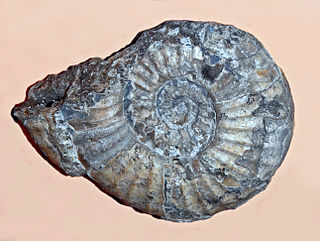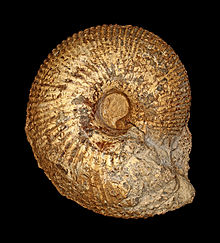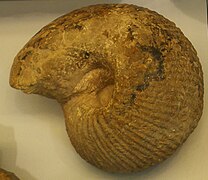
Anapachydiscus is an extinct cephalopod genus from the Upper Cretaceous, Santonian - Maastrichtian of Europe, Africa, Madagascar, S.India, N Z, Calif. Mexico, Argentina, and the Antarctic belonging to the ammonoid family Pachydiscidae.
Ermoceras is a genus of ammonite belonging to the Thomboceratidae family of the Middle Jurassic found in deposites of central Arabia, Sinai, and Algeria with strong primary and secondary ribs and a single row of lateral tubercles; described as having a deep ventral groove
Haplopleuroceras is a Middle Jurassic ammonite and likely member of the Hildoceratacean family Sonniniidae with which it shares the same sort of ribbing.

Psiloceratoidea is a superfamily of Early Jurassic ammonoid cephalopods proposed by Hyatt in 1867, assigned to the order Ammonitida. They were very successful during Hettangian and Sinemurian. Last of them, family Cymbitidae and genera Hypoxynoticeras and Radstockiceras survived into Early Pliensbachian.
The Tarphyceratidae are tightly coiled, evolute Tarphycerida with ventral siphuncles. The dorsum is characteristically impressed where the whorl presses against the venter of the previous. The Tarphyceratidae are derived from Bassleroceras or possibly from some member of the Estonioceratidae.
The Trocholitidae are Tarphycerida with whorls in close contact as with the Tarphyceratidae, but in which the siphuncle, similar in structure, becomes dorsal. The Trocholitidae are derived from the Tarphyceratidae, perhaps from different tarphyceratids.
The Clydonautiloidea are a superfamily within the nautiloid order Nautilida characterized by smooth, generally globular, shells with nearly straight sutures, in early forms, but developing highly differentiated sutures in some later forms. Where known, the siphuncle tends to be central to subcentral.

The Trigonoceratoidea are a superfamily within the Nautilida that ranged from the Devonian to the Triassic, thought to have contained the source for the Nautilaceae in which Nautilus is found.

Grypoceratidae is the longest-lived family of the Trigonoceratoidea, or of the near equivalent Centroceratina; members of the Nautilida from the Upper Paleozoic and Triassic.
The Centroceratidae is the ancestral family of the Trigonoceratoidea and of the equivalent Centroceratina; extinct shelled cephalopods belonging to the order Nautilida
Encoiloceras is a genus of Tainoceratids, a nautiloid cephalopod in the order Nautilida that has been found in Upper Triassic (Carnian) sediments in the Alps and Hungary.

Amaltheidae is a family of eoderoceratoidean ammonitids from the Lower Jurassic consisting of genera characterised by stigated discoidal oxycones—narrow involute shells with narrowly rounded to angular venters that bear a series of grooves, or ridges, along broad flanks, which according to the Treatise L, 1957, evolved into strongly ribbed planulates with quadrate whorls, typically with crenulated keels; involving all together four genera.
Pachyceratidae is a family of Perisphinctoidean ammonites from the upper Middle - and lower Upper Jurassic. Genera within the Pachyceratidae have shells that are in general moderately involte but with most of the inner whorls exposed; whorl sections subquadrate to subtrapezoidal, with rounded venter. Ribbing is strong, in some sharp. Primary ribs typically branch above mid flanks into twos, threes, and even fours.
Indocephalites is a true ammonite and a possible subgenus of Macrocephalites, belonging to the stephanoceratacean family, Macrocephalitidae. Inner whorls form a cadicone, outer become more compressed and smoother. Ribs are simple, crossing the venter straight and uninterrupted. Pleurocephalites, another possible subgenus of Macrocephalites, is quite similar.
Hecticoceras is an ammonite genus belonging to the haploceratoid family Oppeliidae, that lived during the Middle and Late Jurassic, from the Callovian. Hecticoceras may be seen as a series of some nine subgenera, beginning with the lower Callovian H. (Hecticoceras) and H. (Hecticoceratoides) and ending with the lower Oxfordian H. (Pseudobrightia) and H. (Eochetoceras). Hecticocerassensu lato and Prohecticoceras from the underlying Bathonian form the oppeliid subfamily, Hecticoceratinae.
Blanfordiceras is a strongly ribbed, evolute ammonite included in the perisphinctacean family, Neocomitidae that lived during the latest Jurassic. The shell of Blanfordiceras is discoidal, with evolute coiling and all whorls visible so as to have a broad umbilicus. Exposed whorls are ornamented with strong ribbing that arises from the umbilicus, bifurcating on the outer flanks and extending onto the venter. In general form Blanfordiceras is similar to Berriasella, although with a more rounded whorl section.

Mantelliceras is an extinct ammonoid cephalopod genus belonging to the family Acanthoceratidae and type for the Mantelliceratinae, that lived from the Late Albian to the late Cenomanian stage of the Late Cretaceous.

Cadoceras is an extinct ammonite genus belonging to the Cardioceratidae that lived during the Jurassic period from the late Bajocian to the early Callovian.
Ochetoceras is a genus of ammonites, belonging to the Oppeliidae, that lived during the Late Jurassic from the early Oxfordian to the early Tithonian, and type for the subfamily Ochetoceratinae.

Cleviceras is an extinct genus of cephalopod belonging to the family Hildoceratidae. These cephalopods existed in the Jurassic period, during Toarcian and possibly even uppermost Pliensbachian age. Sometimes, it is considered to be a synonym of Eleganticeras.










